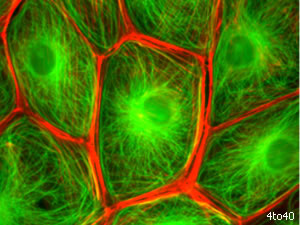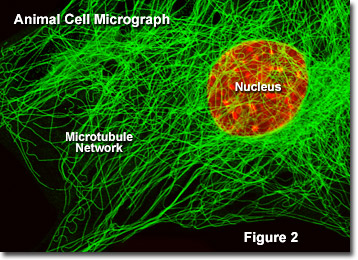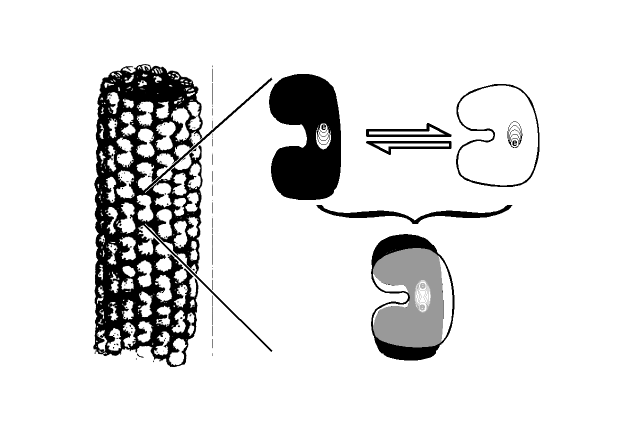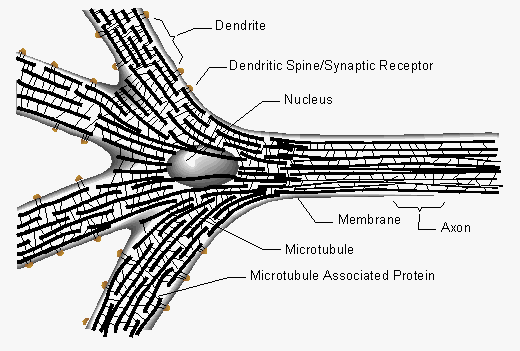Consciousness from Quantum Vibrations?
Consciousness is a phenomenon that seems to resist scientific understanding despite our ever increasing knowledge of brain function. In the mid-1990’s Roger Penrose, a physicist and Stuart Hameroff, an anaesthesiologist came up with a theory that put the focus on quantum activity of microtubules. Now there is research that seems to give support to the unusual theory.
A little background first. Microtubules form part of the internal structure of cells in the human body (see figures 1 & 2). They form part of the scaffolding and their involvement as the ‘railway network’ of the cell is well known. They allow the movement of substances to where they need to be.

Fig 1 – Microscopic view of a group of cells. The red areas are the cell walls, the green ‘whispy’ looking strands are the mircotubules that give the cell shape and help in transport of materials throughout the cell. The darker green ovals are the cell nuclei, which contains the DNA. Taken from: www.4to40.com

Fig 2 – A closer view of a cell where the individual microtubules are clearly visible. Taken from: www.micro.magnet.fse.edu
What Penrose and Hameroff pointed out a while back (~1994) was that the tubulin subunits, which comprise the microtubules, could in fact oscillate or vibrate between two different states. This vibration is actually a physical change in the shape of the tubulin (see figure 3). They do this because depending on certain events in their vicinity, such as the location of electrons, the ‘C’ shaped tubulin could be slightly squished together or stretched apart, much like a small ‘c’ and a capital ‘C’.

Fig 3 – A drawing of a single microtubule on the left, which is made up of numerous tubulin subunits. On the right is an expanded view of a single tubulin and the two possible states that it can exist in. The bottom right part (under the bracket) show the two states superimposed to highlight the shape change. Taken from : www.quantumconsciousness.org
Penrose and Hameroff suggested that the nerve cells in our brains, thought to be responsible for our processing of information, moods and memories, could be turned to conscious sensations by a quantum effect of the tubulin units on mass. As the nerve cell activates an ‘electrical’ impulse passing along and through its body, the activity could in theory cause the microtubules to choose between one of the two physical states – a quantum collapse of sorts that leads to a single physical outcome.
The theory is called ‘Orchestrated Objective Reduction’ or ‘Orch OR’ for short. ‘Orchestrated’ refers to the idea that Microtubule Associated Proteins (MAPs) which can link adjoining microtubules into networks (see figure 4) could adjust or tune the pattern of the quantum collapse, and hence fine tune or change the conscious experience (eg imagining a pink elephant with a slightly different stance). The Objective Reduction (OR) refers to quantum collapse itself.

Fig 4 – Diagram of a single nerve cell (neuron), with dendrites receiving signals from other nerve cells, and outputting a signal along the axon. The microtubule network is within the cell and Microtubule Associated Proteins (MAPs) link certain microtubules in the network. Penrose and Hameroff’s theory suggests that the MAPs could help tune or orchestrate the quantum processing in adjoining microtubules. Taken from: www.quantumconsciousness.org
The theory has been criticised because the brain was thought to be too warm and noisy for any meaningful quantum processing effects. However, a couple of studies are suggesting that the Orch OR theory could actually hold true.
Dr. Anirban Bandyopadhyay and his research lab at the National Institute of Material Sciences, in Tsukuba, Japan have supposedly discovered these quantum vibrations in the microtubules of neurons (see http://www.sciencedaily.com/releases/2014/01/140116085105.htm).
The other study focused on the frequency of the microtubule vibrations. Hameroff knew that the microtubules would be vibrating in the megahertz range (millions of vibrations per second), which is in the same ballpark as the frequencies in which ultrasound machines function. He managed to stimulate his brain using such an ultrasound machine and found to his surprise that his mood was perceptibly affected. Doctoral student, Jay Sanguinetti and his supervisor Prof. John Allen at University of Arizona have been conducting research in the field and apparently with promising results (see http://www.sciencedaily.com/releases/2013/07/13071816525.htm).
